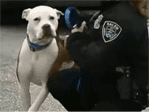"HERO PEOPLE OF THE WEEK" - Sylva Kelegian - The Good, Bad & Ugly About Dog Rescue
 Sylva Kelegian is an actress familiar for her numerous roles in notable film and TV productions (Cold Case, Southland, Rizzoli & Isles, Desperate Housewives, Big Love, Spider-Man, and more). Since entering the world of dog rescue, she has personally rescued over 500 dogs. (And some cats and even a horse.)
Sylva Kelegian is an actress familiar for her numerous roles in notable film and TV productions (Cold Case, Southland, Rizzoli & Isles, Desperate Housewives, Big Love, Spider-Man, and more). Since entering the world of dog rescue, she has personally rescued over 500 dogs. (And some cats and even a horse.)
Sylva states that being an actress can at times be very self-involved and she admits to hitting a brick wall one day, realizing that she had to do something to give back. Sylva then decided to split her time between acting and rescuing animals.
Over the years, Sylva has been in the trenches of dog rescue in NY, LA and points in between, rescuing over 500 dogs. She had so many stories and information about rescuing animals that she wanted to share them. Her book, GOD SPELLED BACKWARDS: The Journey of an Actress into the World of Dog Rescue shows us a world many know little about. Her book educates, entertains and also enlightens people about what's really going on out there and how much need there is. She chronicles the good, the bad, the ugly and the scary.
The rescue world for Sylva all started when the newlywed showed up at a Manhattan veterinary clinic to walk a rescue dog and a strawberry blonde puppy stumbled down the stairs and into her heart, opening it to the plight of hurt and abandoned dogs everywhere.
Sylva then moved to Los Angeles with her actor husband and her new dog Sammy. She needed something fulfilling to do between acting jobs so she started volunteering at a rescue group. She said living in Los Angeles is, "Kind of like a third world country when it comes to the animals!" There are many thousands of animals living on the streets every day, with thousands being killed every day in shelters.
 In one dangerous Los Angeles neighborhood, she rescued 20 dogs; in another, 40 dogs including mothers and puppies.
In one dangerous Los Angeles neighborhood, she rescued 20 dogs; in another, 40 dogs including mothers and puppies.
Sylva has spent many thousands of dollars of her own money, not to mention countless hours and days over the years, to care and provide for homeless animas. This included medical care, spaying, neutering and boarding animals until she could find them homes. Unfortunately, she could never bring these animals into her home, because she has her own three dogs and wanted to keep her household sane! So she either found foster homes or had them boarded at facilities, at her own expense, until she could find them the right home. Along with all of this, Sylva also did home-checks to make sure any animals she placed into homes would be living indoors as a family member and not confined to a backyard.
Her story reveals what one determined woman can accomplish in the hope that, one day, man's best friend will be treated as such.
Kelegian is also the author of a children's book, The Dolphin Princess, just published. A portion of the proceeds from the sale of her book were donated to animal rescue organizations.
Visit Website
Keep Weight Off Pets In Winter
Dr. Marty Becker, America's Favorite Veterinarian
 If your pet is overweight, there is a chance that you might be too. But the good news is you can lose weight together. Studies show that people were better at losing weight when they walked with their pet, as opposed to walking with other people. Why? Humans have a busy life and can come up with lots of excuses not to go for a walk. They might have to work, pick the kids up or not feel well. But, your pet never has a better offer and will nag you to get you off the floor and out the door!
If your pet is overweight, there is a chance that you might be too. But the good news is you can lose weight together. Studies show that people were better at losing weight when they walked with their pet, as opposed to walking with other people. Why? Humans have a busy life and can come up with lots of excuses not to go for a walk. They might have to work, pick the kids up or not feel well. But, your pet never has a better offer and will nag you to get you off the floor and out the door!
Walking is not only good for your dog's body; it is also good for their mind. A tired dog is a happy dog. Walking also helps with boredom.
Sadly, if you look at the numbers from the Association for Pet Obesity Prevention, it keeps climbing every year. Currently, 56-percent of America's pets are overweight or obese. They are like little tubby time bombs ticking away their health.
Dr. Becker tells us he has a Golden Retriever, a Lab Pit Mix and two canine cocktails and they all weight exactly the same as they did, within 1/3 of a pound, of what they weighed at one year of age. They are all lean.
Some people claim that their pets got fat after being sprayed or neutered. But they don't have to. It is all how you raise them and what you feed them. But even worse, most people who have an overweight pet think they are at an ideal weight, because there is no bikini season for dogs. They don't try to get into a swimsuit for a Caribbean cruise or need to get into last year's jeans. They think their pet is just fluffy or has a lot of hair.
 But it is easy to see if your pet is overweight with a simple test that you can do at home. A veterinarian usually looks at three things to determine if a pet is overweight. They look for a light layer of fat over the ribs, where you can still feel the ribs. If you look at them in profile, you are looking at a tucked abdomen, so that there is an indentation at the waist where it looks somewhat like a wasp, not a cylinder or tube. And lastly, when you look down on them from above, you should see an indentation at their waist. It should look like an hourglass.
But it is easy to see if your pet is overweight with a simple test that you can do at home. A veterinarian usually looks at three things to determine if a pet is overweight. They look for a light layer of fat over the ribs, where you can still feel the ribs. If you look at them in profile, you are looking at a tucked abdomen, so that there is an indentation at the waist where it looks somewhat like a wasp, not a cylinder or tube. And lastly, when you look down on them from above, you should see an indentation at their waist. It should look like an hourglass.
Veterinarians don't charge for weight checks, so if you're not sure, take them in to see if they are overweight. If your pet is overweight, they can tell you how to get the weight off.
Your pet should typically lose 1 and 1/2 percent of their body weight per week, sort of like Weight Watchers in humans. For example, if your pet weighs 30 pounds but they should only weigh 20 pounds, you need take off 1 and 1/2 percent of 30 pounds per week. This is not very much, but in the course of one month, it adds up to 1.6 pounds of loss. It might take a while, maybe 4 to 6 months to get the weight off, which is ideal, as you don"t want to do it too fast.
 But even if you get 1/3 of the weight off, you get most of the benefits. So your pet doesn't have to get down to 20 pounds. Even if you only get them down to 26 pounds, you still get most of the benefits. The pet might start jumping back up on the couch, running up the stairs again and should be more energetic.
But even if you get 1/3 of the weight off, you get most of the benefits. So your pet doesn't have to get down to 20 pounds. Even if you only get them down to 26 pounds, you still get most of the benefits. The pet might start jumping back up on the couch, running up the stairs again and should be more energetic.
No one needs to have an overweight pet. You just need to adjust how much they eat. So if you give them treats throughout the day, make sure you take away a portion of their meals. Food puzzles are also a great way to feed their minds as well as their bodies. But whatever you do, don't free feed, which means don't have food available at all times.
Dr. Becker tells us that there are two things to do for the furry fountain of youth. One is keeping your pet at or near it's ideal body weight and the other is some kind of daily oral care. It doesn't have to be brushing their teeth; it can also be some kind of edible chew or an oral sealant from a veterinarian. These two things together can add up to about 30 percent more time to a pet's life and a healthier life at that!
Visit Fear Free Happy Homes for tips on making your home fear free and to locate a Fear Free Veterinarian near you. Go to Fear Free Pets to become certified.
Listen and Explore the Fear Free Expert Series
 Vegas Bats Positive for Rabies - What's the Risk? - Dr. Debbie
Vegas Bats Positive for Rabies - What's the Risk? - Dr. Debbie
Think your pet doesn't need a rabies vaccine because it lives indoors? Think again. Bats have been known to fly through open windows or chimneys. Dogs and cats that go outdoors are at risk for rabies exposure through wildlife. Felines that hunt and bring "presents" have added rabies risk.
What is Rabies?
Rabies is a viral disease causing encephalitis (brain inflammation) that affects all mammals including humans. The disease is almost always fatal. Over 59,000 people worldwide die of rabies every year, but fortunately U.S. human deaths are rare with 1 to 2 reported per year. Pet and farm animal rabies cases do occur in the U.S. though, usually after tangling with wildlife.
How is Rabies Passed?
Rabies is passed in saliva through the bite of a rabid animal. Less common exposures to rabies include aerosol transmission, mucous membrane contact, or rare cases of organ transplant in humans.
What Are Symptoms of Rabies?
Excessive drooling, aggression, staggering and seizures are symptoms of rabies in animals. Wild carnivores, like coyotes, that avoid people are suspect if lacking fear and approaching humans. Nocturnal species like bats that are found out during daylight are also suspect for rabies.
What Kind of Animals Carry Rabies?
Although pet and human rabies cases in the U.S. are rare, the infection still abounds in wildlife reservoirs. In the Las Vegas area, bats are most commonly carriers, but other wildlife carriers include raccoons, skunks and foxes.
What Do You Do If You See a Sick or Dying Bat?
Avoid contact with sick or dying bats. Do not take sick bats to the veterinarian. Call Animal Control if any human or pet exposure to sick bat.
 Despite the rabies concern, bats do have an important role in our ecosystem by consuming insects and pollinating plants. Not every bat has rabies, and there are other reasons bats die.
Despite the rabies concern, bats do have an important role in our ecosystem by consuming insects and pollinating plants. Not every bat has rabies, and there are other reasons bats die.
What Do I Do If a Person or Pet is Scratched or Bitten By a Bat or Other Wildlife?
If your pet gets into a fight with a skunk or raccoon, or plays with a dying or dead bat, there is potential for rabies exposure and a report should be made. Call animal control to have the bat or other wildlife picked up.
Possible rabies exposure is evaluated on a case-by-case basis. Because rabies is fatal, any humans with suspect rabies exposure should make a report to the local health department. Fortunately post exposure treatment for people is very effective in preventing disease, and doesn't involve painful stomach injections reported of long ago.
What Happens to Pets After Exposure to Suspected or Known Rabies?
Ultimately local rabies ordinances dictate how each case is handled. Pets with current or late rabies vaccinations may be quarantined for 10 days.
A pet that never has had a rabies vaccine may be promptly euthanized and tested for rabies. In other cases of unvaccinated pets, extended quarantine periods up to 6 months may arise.
What Can I Do to Protect My Pets and Family From Rabies?
- Vaccinate animals for rabies - this includes dogs, cats, ferrets and select farm animals.
- Teach children never to handle bats.
- Do not keep wild animals as pets.
- Spay and neuter your pets to decrease the desire to roam.
- Maintain control of your pets when outdoors or hiking to avoid accidental exposure to wildlife.
- Bat-proof your home and garage to avoid nesting sites and close encounters with bats.
- Report human bites from pets or wildlife to public health and animal control authorities.
Vaccination is key to protecting pets from rabies and offers peace of mind to pet owners. Rabies vaccine is typically inexpensive.
Rabies vaccination…Just do it!
Featured veterinarian known as "Dr. Debbie" on national pet radio program, Animal Radio. Ebook author of "Yorkshire Terriers: How to Be Your Dog's Best Friend"; "Pugs: How to Be Your Dog's Best Friend"; "Mini Schnauzers: How to Be Your Dog's Best Friend"; and "Shih Tzu: How to Be Your Dog's Best Friend." Dr. Debbie's books.
Visit Website
Animal Radio News with Tammy Trujillo
 How Far Would You Go To Get Your Lost Dog Back?
How Far Would You Go To Get Your Lost Dog Back?
One woman in Vermont didn't give up on her dog even though he had been missing for five months. The dog took off after her car went off the road and hit a tree in a mountainous area. She let him out after the crash and he ran away, traumatized. The dog had been spotted several times, but ran anytime anyone got close. The woman tried leaving out everything from rotisserie chicken, to bacon, to dog toys to lure him into animal traps. More than a dozen volunteers and even a psychic tried to help, with no luck. People all through the area continued to keep an eye out for the dog, putting out food, checking traps and following up every lead.
College Pet Therapy
There is not much out there to make taking college finals fun, but one state university found a way to make them a bit less stressful - a little pet therapy. It set up a room at the library where stressed out students could come in and spend some time playing and petting a group of dogs. Each dog was a certified therapy dog or had the seal of approval from the Canine Good Citizen Program. We don't know if it helped improve grades on the finals, but the students said it helped them chill out between finals. In fact, there was a non-stop line out the door to get a chance to spend time with the dogs.
 Incredible Tale Of Survival
Incredible Tale Of Survival
This tale of survival deals with a cat. His family was moving from Virginia to Hawaii and just before they were ready to go, their cat disappeared. They postponed their move for three days hoping that she would show up, thinking she might have gotten out the door as movers were taking out boxes and furniture. But then they finally had to go. They got to Hawaii and 36 days later their belongings arrived. They heard a very faint meow coming from one of the boxes. Yep, there was their cat, somehow still alive, just barely after having no food, water or light for over a month. The cat recovered, but due to rules in Hawaii, had to stay in quarantine, where the family visited her nearly every day. The family claims that the moving company may have deliberately put their cat in the box. They said she was actually inside of a taped shut box in the mattress box, which they felt just could not have happened on accident. Whether it was intentional or not, everyone's really glad that the cat was okay.
Lufthansa Airlines Welcomed Falcons
Falcons are welcome passengers aboard Lufthansa airlines. Falcons are allowed in the main cabin in a "specially designed 'Falcon Master' tray" that keeps the bird from messing on the cabin walls, seats and carpets. Why falcons? It was an effort by Lufthansa to try and drum up business in the Middle East, where apparently a lot of people have pet falcons. Many airlines, of course, do allow domesticated animals like cats, dogs and even birds (usually up to 20 pounds), but airlines like United, American and Delta, prohibit the carriage of poultry or birds of prey.
 Check Out This Video by Prank It Forward
Check Out This Video by Prank It Forward
A site called Prank It Forward stages events all over the country to help deserving individuals. They even set one up for the employees and animals at the Kentucky Humane Society in Louisville. Comedian Tom Mabe went in and told the people at the front desk that he wanted to make a donation of some items for the animals. They said great, and in comes a seemingly line of people bringing in thousands of dollars worth of pet food, treats, toys, kitten milk formula, cat litter and beds, enough to pretty much fill the lobby, followed by 10 people from a nearby grooming shop who bathed and spruced up every single dog in the shelter. It was a great day for all the animals, but an even better one for one little terrier mix. Host Tom Mabe fell in love with him and took him home.
 Here's a Mystery!
Here's a Mystery!
How did 4-year-old bulldog end up 1,500 miles from home? No one knows and he doesn't seem to be any worse for wear from the trek from his home in Florida to New Hampshire. Two women found him walking the streets in Salem, New Hampshire. A scan at the local shelter showed Cooper had a microchip. Cooper's guardian got a call about her missing bully. It's not the first mystery in the bulldog's life; he originally showed up out of the blue on his new guardian's doorstep in Florida. The woman tried to find out where he'd come from, but no one claimed him. So she got him microchipped and kept him. A national charity called Kindred Heart Transport stepped in to get Cooper back home to Florida.
 Listen to the entire Podcast of this show (#1253)
Listen to the entire Podcast of this show (#1253)





